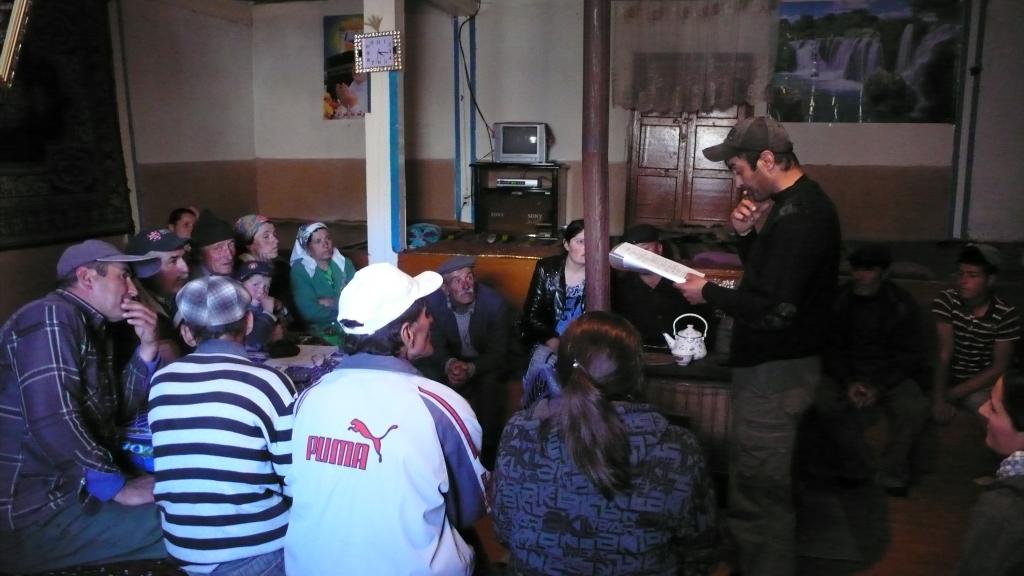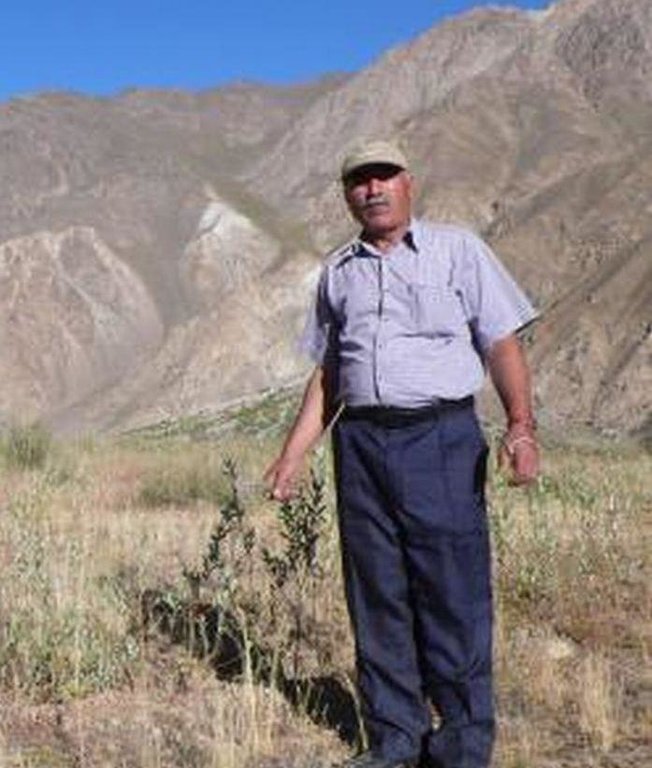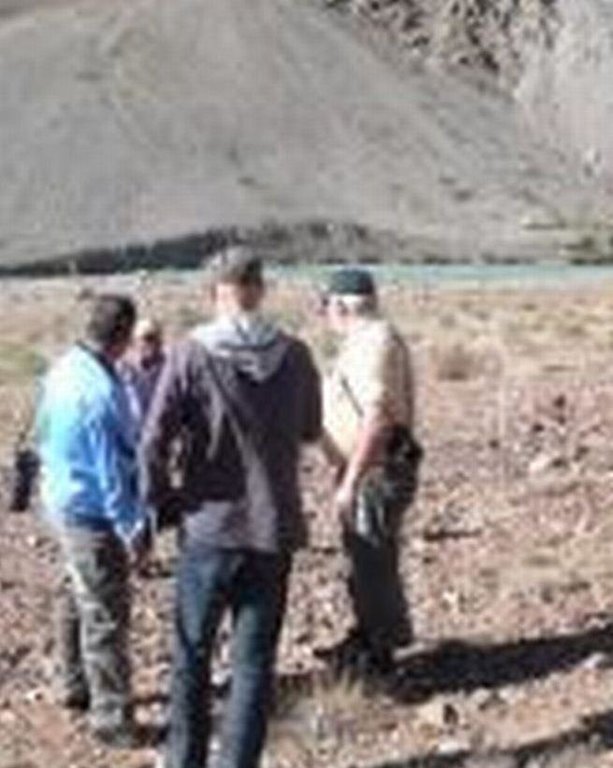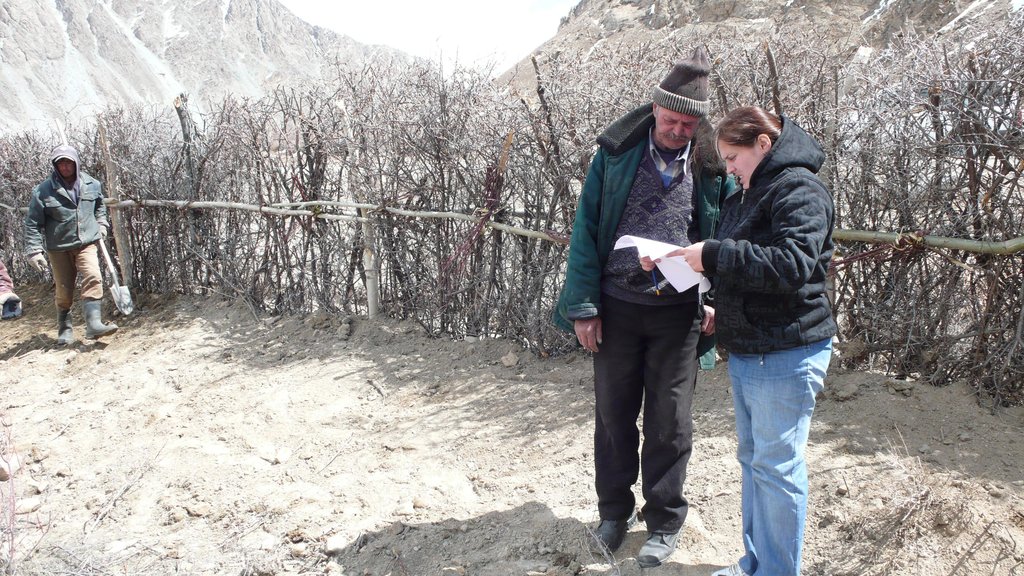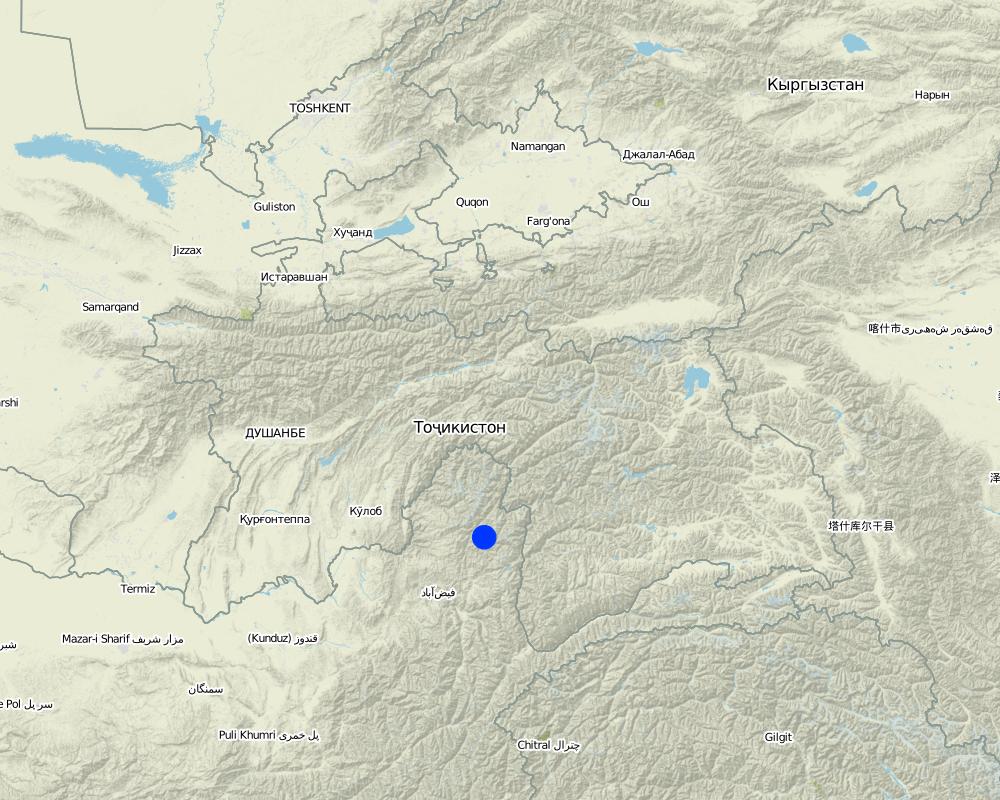Savings Book Approach [ຕາຈິກິສະຕານ]
- ການສ້າງ:
- ປັບປູງ:
- ຜູ້ສັງລວມຂໍ້ມູນ: Roziya Kirgizbekova
- ບັນນາທິການ: –
- ຜູ້ທົບທວນຄືນ: David Streiff
Sberegatelnaya knizhka (Russian)
approaches_2445 - ຕາຈິກິສະຕານ
ເບິ່ງພາກສ່ວນ
ຂະຫຍາຍທັງໝົດ ຍຸບທັງໝົດ1. ຂໍ້ມູນທົ່ວໄປ
1.2 ລາຍລະອຽດ ການຕິດຕໍ່ ຂອງບຸກຄົນທີ່ຊັບພະຍາກອນ ແລະ ສະຖາບັນ ການມີສ່ວນຮ່ວມ ໃນການປະເມີນຜົນ ແລະ ເອກະສານ ຂອງວິທີທາງ
ຜູ້ຊ່ຽວຊານ ດ້ານການຄຸ້ມຄອງ ທີ່ດິນແບບຍືນຍົງ:
Neusel Benjamin
benjamin.neusel@cimonline.de
GIZ
Sustainable Management of Natural Resources in Gorno-Badakhshan, Okhonjon Str. 58-1, 736000 Khorog
ເຢຍລະມັນ
ຜູ້ຊ່ຽວຊານ ດ້ານການຄຸ້ມຄອງ ທີ່ດິນແບບຍືນຍົງ:
Kirchhoff Joachim
+992 44 6006702
joachim.kirchhoff@giz.de
GIZ
Regional Program on Sustainable Use of Natural Resources in Central Asia, Ayni Str./Nazarshoev Str., 734026 Dushanbe
ເຢຍລະມັນ
ຊື່ຂອງ ສະຖາບັນການຈັດຕັ້ງ ທີ່ອໍານວຍຄວາມສະດວກ ໃນການສ້າງເອກກະສານ ຫຼື ປະເມີນແນວທາງ (ຖ້າກ່ຽວຂ້ອງ)
Central Asian Countries Initiative for Sustainable Land Management - Multicountry Capacity Building (CACILM - MCB) - ກີກັດຕັນຊື່ຂອງ ສະຖາບັນການຈັດຕັ້ງ ທີ່ອໍານວຍຄວາມສະດວກ ໃນການສ້າງເອກກະສານ ຫຼື ປະເມີນແນວທາງ (ຖ້າກ່ຽວຂ້ອງ)
Deutsche Gesellschaft für Internationale Zusammenarbeit (GIZ) GmbH (GIZ) - ເຢຍລະມັນ1.3 ເງື່ອນໄຂ ຂອງການນໍາໃຊ້ເອກກະສານຂໍ້ມູນ ຂອງ WOCAT
ເມື່ອໃດທີ່ໄດ້ສັງລວມຂໍ້ມູນ (ຢູ່ພາກສະໜາມ)?
15/09/2010
ຜູ້ສັງລວມ ແລະ ບັນດາຜູ້ຕອບແບບສອບຖາມ ຍອມຮັບໃນເງື່ອນໄຂ ການນໍາໃຊ້ຂໍ້ມູນເອກະສານ ທີ່ສ້າງຂື້ນ ໂດຍຜ່ານ ອົງການ WOCAT:
ແມ່ນ
1.4 ເອກະສານອ້າງອີງ (ຫຼາຍ) ກັບແບບສອບຖາມ (ຫຼາຍ) ເຕັກໂນໂລຢີ ຂອງດ້ານການຄຸ້ມຄອງ ດິນແບບຍືນຍົງ
2. ພັນລະນາ ແນວທາງການຄຸ້ມຄອງນໍາໃຊ້ດິນແບບຍືນຍົງ
2.1 ການອະທິບາຍ ໂດຍຫຍໍ້ ຂອງວິທີທາງ
Reforestation of deserted state forest plots through a financial incentive system for the labour intensive first years of forest establishment, after which harvests of forest products from the plot provide income opportunities for the forest tenants and the State Forestry Agency (in the frame of CACILM).
2.2 ການອະທິບາຍ ລາຍລະອຽດ ຂອງວິທີທາງ
ການອະທິບາຍ ລາຍລະອຽດ ຂອງວິທີທາງ:
Aims / objectives: The main objective of the approach is the reforestation of a completely deserted former forest area in collaboration with the local population. However, as reforestation is highly labour intensive especially in the initial phases, this approach was developed as an incentive system to overcome this high-labour/low-income phase.
Methods: The underlying method is the implementation of Joint Forestry Management (JFM) on severely degraded forest plots (For JFM see approach TAJ015). In order to enable reforestation on such plots, an incentive system has been developed to bridge the gap when the initial workload is high, but no forest resources can yet be harvested. Therefore, selected forest tenants receive a savings book with a total amount of money to be obtained for forest rehabilitation work within the next six years. Every year clear planting and rehabilitation goals are formulated, which have to be completed by an agreed deadline. All tenants who completed their annual tasks will get access to a share of the total amount in the savings book. The annual shares gradually decreases over a period of six years, after which access to forest resources on the rehabilitated plot will be substantial enough to provide income opportunities and forest resources for their own consumption. According to the JFM contract, forest tenants hold a plot for a period of 20 years. This also applies for the savings book tenants, who act as regular JFM tenants after the subsidised reforestation period of six years is over.
Stages of implementation: The savings book approach is designed to cover a period of six years, and includes the following; (1) Before implementation; the willingness of the local population to participate needs to be assessed, the feasibility of reforestation, costs for irrigation, possibilities and the need for fencing and possible conflicts and challenges that might occur. (2) In the first year a living fence (seabuckthorn) has to be established, and the irrigation system has to be fully rehabilitated. (3) During the first three years of the approach implementation tenants will reforest one third of their plot each year (1-2 ha per household), introducing a rotation system that will be used for harvesting. (4) During years 4-6, mainly maintenance work will be conducted (pruning, fence and irrigation maintenance).
Role of stakeholders: The JFM rental contract is valid for 20 years and defines the rights and duties of the forest tenants and the State Forestry Agency. While the tenant is responsible for the agreed annual reforestation tasks, the Forestry Agency provides the required planting material, technical support and monitoring. The Micro Loan Organisation MADINA, facilitates the financial transactions required for the implementation and management of the savings books.
2.3 ຮູບພາບຂອງແນວທາງ
2.5 ປະເທດ / ເຂດ / ສະຖານທີ່ບ່ອນທີ່ແນວທາງໄດ້ຖືກນໍາໃຊ້
ປະເທດ:
ຕາຈິກິສະຕານ
ພາກພື້ນ / ລັດ / ແຂວງ:
Tajikistan, Gorno Badakhshan Autonomous Region
ຂໍ້ມູນເພີ່ມເຕີມຂອງສະຖານທີ່:
Shugnan
Map
×2.6 ວັນທີເລີ່ມຕົ້ນ ແລະ ສິ້ນສຸດ ການຈັດຕັ້ງປະຕີບັດ ວິທີທາງ
ສະແດງປີຂອງການເລີ່ມຕົ້ນ:
2010
ປີທີ່ສີ້ນສູດ (ຖ້າຢຸດບໍ່ໄດ້ນໍາໃຊ້ ວິທີທາງ):
2012
2.7 ປະເພດຂອງແນວທາງ
- ພາຍໃຕ້ໂຄງການ / ແຜນງານ
2.8 ເປົ້າໝາຍ / ຈຸດປະສົງຫຼັກ ຂອງການຈັດຕັ້ງປະຕິບັດ ວິທີທາງ
The Approach focused mainly on SLM with other activities (Income generation, income diversification, reforestation of severely degraded forest areas, improved access to forest resources)
Reforestation and protection of severely degraded state forest plots in cooperation with the local forest users. At the same time, providing an incentive system for the initial reforestation phase, when a high workload is required but no forest products can be harvested. The main objective is therefore to combine forest rehabilitation with livelihood improvement (increased income generation and forest resource accessibility) and to directly involve the local population in the management and rehabilitation of the State forest resources close to their village. The approach will be implemented within the framework of Joint Forestry Management (see approach TAJ015).
The SLM Approach addressed the following problems: The forest area close to the village was completely destroyed during the civil war to meet urgent fuelwood needs. At the same time the State Forestry Agency does not have the necessary financial, management and control capacities to reforest degraded areas. Despite the presence of a forested area close to the village, local inhabitants do not have the labour force and the financial resources to rehabilitate the plot and the irrigation infrastructure on their own. These highly degraded or deserted forest plots aim to be re-established through the savings book approach, by combining long-term rental contracts for individual plots, financial incentives for the initial reforestation efforts, and user rights to the resources growing on the plot in future.
2.9 ເງື່ອນໄຂອໍານວຍ ຫຼື ຂັດຂວາງການປະຕິບັດຂອງເຕັກໂນໂລຢີ / ເຕັກໂນໂລຢີການນໍາໃຊ້ຕາມແນວທາງ
ມີຄວາມສາມາດ / ເຂັ້າເຖິງຊັບພະຍາກອນດ້ານການເງິນ ແລະ ການບໍລິການ
- ເຊື່ອງຊ້ອນ
On highly degraded plots the initial labour and financial input for reforestation is very high and cannot be met either by forest tenants nor by the State Forestry Agency.
Treatment through the SLM Approach: The plots are rented to local forest tenants, who receive a savings book with a certain amount of money for rehabilitation activities for six years. The work is strictly monitored and money can be accessed only if the annual tasks are completed.
ການກໍ່ຕັ້ງສະຖາບັນ
- ເຊື່ອງຊ້ອນ
The State Forestry Agency lacks the institutional capabilities to implement, manage and control reforestation and forest management activities.
Treatment through the SLM Approach: Income opportunities are handed over to local forest tenants. Forestry Agency staff are also trained in monitoring and sustainable management of the rented plots.
ກ່ຽວກັບກົດໝາຍ (ສິດນໍາໃຊ້ດິນ, ສິດນໍາໃຊ້ນໍ້າ)
- ເຊື່ອງຊ້ອນ
Local inhabitants had no official user rights to the state forest plots close to their village and were using the plots illegally. Hence there is no real interest in rehabilitating the plots.
Treatment through the SLM Approach: The forest plots are rented and contracts, management and annual plans are established for each plot. Additionally, the major costs for reforestation are covered for the first few work intensive years.
The existing land ownership, land use rights / water rights moderately hindered the approach implementation Before the implementation of this approach the deserted forest area was governed by open access, although it formally belonged to the State Forestry Agency. Local villagers used it intensely as winter pastures. Therefore, not everybody was happy to restrict access to the area. However, it is clear to the local land users, that reforestation and irrigation rehabilitation will enable better access to forest products and fodder in the long run.
ຄວາມຮູ້ກ່ຽວກັບການຄຸ້ມຄອງ ທີ່ດິນແບບຍືນຍົງ, ການເຂົ້າເຖິງການສະໜັບສະໜູນ ທາງດ້ານວິຊາການ
- ເຊື່ອງຊ້ອນ
The State Forestry Agency lacks financial and technical resources to rehabilitate degraded forest areas and the respective irrigation infrastructure.
Treatment through the SLM Approach: Shortcomings in irrigation are analysed and improved at the beginning of rental agreements with local villagers. Technical and financial support from the project is provided where infrastructure needs much assistance.
ວຽກ, ມີກໍາລັງຄົນ
- ເຊື່ອງຊ້ອນ
After the collapse of the Soviet Union, the State Forestry Agency had insufficient financial and human resources to manage the state forests.
Treatment through the SLM Approach: Through Joint Forestry Management and hence also through the savings book approach the workload in the forest (but also the incomes from forest products) is shared with local forest tenants.
3. ການມີສ່ວນຮ່ວມ ແລະ ບົດບາດຂອງພາກສ່ວນທີ່ກ່ຽວຂ້ອງທີ່ໄດ້ມີສ່ວນຮ່ວມ
3.1 ຜູ້ມີສ່ວນຮ່ວມ ໃນວິທີທາງ ແລະ ພາລະບົດບາດ ຂອງເຂົາເຈົ້າ
- ຜູ້ນໍາໃຊ້ດິນໃນທ້ອງຖິ່ນ / ຊຸມຊົນທ້ອງຖິ່ນ
Forest plot tenants are the central implementing actors for reforestation
The approach is open to all economical categories within the village, regardless of age, status or ethnicity.
Several seminars on the design and implementation of the approach were held, whereas the whole community was invited, including men and women, young and old villagers
Although women and men were equally invited and encouraged to participate in the information seminars, most of the women felt that the work that would need to be done would need to be carried out by men.
As the work to be conducted was described as hard and strenuous, no women wanted to hold a forest plot under the savings book approach. However, women participated in discussions on the implementation of the approach and sometimes also took the place of men regarding decision making and implementation.
- ຜູ້ຊ່ຽວຊານ ການນຄຸ້ມຄອງ ທີ່ດິນແບບຍືນຍົງ / ທີ່ປຶກສາດ້ານກະສິກໍາ
Specialists from the project and the State Forestry Agency were the main actors for the design of the approach and its adaptation to local conditions
Initially developed in Vietnam, the approach was adapted and further developed by the GIZ project. During the design process, international as well as national specialists were involved, and inputs from local forest users were integrated as well.
- ພາກເອກະຊົນ
Micro-loan organisation MADINA
- ອໍານາດ ການປົກຄອງທ້ອງຖິ່ນ
Governmental decision makers in the sphere of forestry and environmental management (State Forestry Agency of GBAO and Shugnan District)
- ອົງການຈັດຕັ້ງ ສາກົນ
Deutsche Geselschaft für Internationale Zusammenarbeit GmbH (GIZ)
3.2 ການມີສ່ວນຮ່ວມຂອງຜູ້ນໍາໃຊ້ທີ່ດິນໃນທ້ອງຖິ່ນ / ຊຸມຊົນທ້ອງຖິ່ນໃນໄລຍະທີ່ແຕກຕ່າງກັນຂອງແນວທາງ
| ການລວບລວມ ເອົາຜູ້ນໍາໃຊ້ດິນ ໃນທ້ອງຖິ່ນ / ຊຸມຊົນທ້ອງຖິ່ນ | ໃຫ້ລະບຸ ຜູ້ໃດທີ່ມີສ່ວນຮ່ວມ ໃນແຕ່ລະກິດຈະກໍາ? | |
|---|---|---|
| ການເລີ່ມຕົ້ນ / ແຮງຈູງໃຈ | ການຮ່ວມມື | Initial field visits, information seminars, discussions, involvement of the whole community. |
| ການວາງແຜນ | ການຮ່ວມມື | The technical planning of the approach was mainly conducted by forestry specialists, whereas the local villagers were consulted in an interactive way in order to adapt the approach to the specific conditions on site (e.g. solution of irrigation problem, planting techniques etc.). |
| ການປະຕິບັດ | ການຊ່ວຍເຫຼືອຈາກພາຍນອກ | After the initial reforestation phase the tenants will be involved in the participatory JFM system. |
| ຕິດຕາມກວດກາ / ການປະເມີນຜົນ | ການຮ່ວມມື | Progress and results are monitored in close cooperation between the State Forestry Agency, the plot tenants and project staff. Successes and challenges are documented and discussed, which if needed lead to an adaptation in the approach design. |
| Research | ການບໍ່ປະຕິບັດ | Research is currently being conducted at a the local level, involving the local population as well as Forestry Agency staff for interviews and field visits. |
3.4 ການຕັດສິນໃຈກ່ຽວກັບການຄັດເລືອກເຕັກໂນໂລຢີຂອງການຄຸ້ມຄອງທີ່ດິນແບບຍືນຍົງ / ເຕັກໂນໂລຢີ
ລະບຸ ຄົນທີ່ຕັດສິນໃຈ ກ່ຽວກັບການຄັດເລືອກຂອງ ເຕັກໂນໂລຢີ / ເຕັກໂນໂລຢີ ຈະໄດ້ຮັບການປະຕິບັດ:
- ຜູ້ຊ່ຽວຊານ ຫຼັກດ້ານການຄຸ້ມຄອງ ທີ່ດິນແບບຍືນຍົງ, ມີການຕິດຕາມປຶກສາຫາລືກັບຜູ້ນໍາໃຊ້ທີ່ດິນ
ອະທິບາຍ:
The savings book approach was initially developed and tested in Vietnam. The idea to implement such an approach in GBAO came from a GIZ project. Nevertheless, the local population was involved in several discussions about the adaptation of the approach to the local conditions.
Decisions on the method of implementing the SLM Technology were made by mainly by SLM specialists with consultation of land users
4. ການສະໜັບສະໜູນທາງດ້ານວິຊາການ, ການສ້າງຄວາມສາມາດ, ແລະ ການຈັດການຄວາມຮູ້.
4.1 ການສ້າງຄວາມສາມາດ / ການຝຶກອົບຮົມ
ຜູ້ນໍາໃຊ້ທີ່ດິນ ຫຼື ພາກສ່ວນກ່ຽວຂ້ອງອື່ນໆ ໄດ້ຮັບການຝຶກອົບຮົມບໍ່?
ແມ່ນ
ໃຫ້ລະບຸ ຜູ້ໃດທີ່ໄດ້ຮັບການຝຶກອົບຮົມ:
- ຜູ້ນໍາໃຊ້ດິນ
- ພະນັກງານພາກສະໜາມ / ທີ່ປຶກສາ
ຖ້າເປັນໄປໄດ້, ໃຫ້ລະບຸເພດ, ອາຍຸ, ສະຖານະພາບ, ຊົນເຜົ່າ, ແລະ ອື່ນໆ:
As for JFM (see approach TAJ015), in the first step 'mobilisers' and Forestry Agency staff were trained as field staff. In the second step, they provided training, information and advice for the forest tenants.
ຮູບແບບຂອງການຝຶກອົບຮົມ:
- ການເຮັດຕົວຈິງ
- ເນື້ອທີ່ສວນທົດລອງ
- ກອງປະຊຸມ
- ຫຼັກສູດ
ໃນຫົວຂໍ້:
Sustainable natural resource management, technical forest management (cutting and planting of trees, maintenance of a forest area, building of living seabuckthorn fences), elaboration of management plans and annual plans for a sustainable and joint management of the forest plot between forest tenants and the State Forestry Agency.
4.2 ການບໍລິການໃຫ້ຄໍາປຶກສາ
ເຮັດຜູ້ໃຊ້ທີ່ດິນມີການເຂົ້າເຖິງການບໍລິການໃຫ້ຄໍາປຶກສາ?
ແມ່ນ
ລະບຸວ່າການສະໜອງ ການບໍລິການ ໃຫ້ຄໍາປຶກສາ:
- ໃນພື້ນທີ່ຂອງຜູ້ນໍາໃຊ້ດິນ
ອະທິບາຍ / ຄວາມຄິດເຫັນ:
Name of method used for advisory service: Forestry training for tenants; Key elements: Sustainable natural resource management and use, Technical training in forestry management (planting and harvesting, fencing etc.)
Advisory service is quite adequate to ensure the continuation of land conservation activities; Strong interest from tenants as well as State Forestry Agency to continue with this approach. However, due to the short time the approach is being implemented, still more training and practice will be needed to ensure an experienced, effective and reliable advisory service by Forestry Agency staff.
4.3 ສະຖາບັນການສ້າງຄວາມເຂັ້ມແຂງ (ການພັດທະນາອົງການຈັດຕັ້ງ)
ສະຖາບັນ ໄດ້ຮັບການສ້າງຕັ້ງຂື້ນ ຫຼື ໄດ້ຮັບການສ້າງຄວາມເຂັ້ມແຂງ ໂດຍການຈັດຕັ້ງປະຕິບັດ ວິທີທາງບໍ່?
- ມີ, ພໍສົມຄວນ
ລະບຸ ທາງສະຖາບັນ ໄດ້ສ້າງຄວາມເຂັ້ມແຂງ ໃນລະດັບໃດ (ຫຼາຍ):
- ທ້ອງຖິ່ນ
ລະບຸ ປະເພດ ຂອງສະໜັບສະໜູນ:
- ທາງດ້ານການເງິນ
- ການສ້າງຄວາມອາດສາມາດ / ການຝຶກອົບຮົມ
ໃຫ້ລາຍລະອຽດເພີ່ມເຕີມ:
The State Forestry Agency is being trained and supported to implement and monitor the approach on their own, and to offer advisory services. Additionally the forest tenants are encouraged and supported to act as a group and to advocate their needs and problems as a local civil society organisation
4.4 ຕິດຕາມກວດກາ ແລະ ປະເມີນຜົນ
ການຈັດຕັ້ງປະຕິບັດ ວິທີທາງ ໄດ້ມີການປະເມີນຜົນ ແລະ ຕິດຕາມບໍ?
ແມ່ນ
ຄວາມຄິດເຫັນ:
technical aspects were ad hoc monitored by project staff, government through observations; indicators: condition of the irrigation and fencing infrastructure
socio-cultural aspects were ad hoc monitored by project staff, land users through observations; indicators: discussion of problems and challenges
economic / production aspects were regular monitored by project staff, government through observations; indicators: control of planting process, technical advice
economic / production aspects were regular monitored by project staff, government through measurements; indicators: control of seedlings planted (first 4 years), amount of harvested forest products (from 5th year on)
area treated aspects were regular monitored by project staff, government through measurements; indicators: monitoring of area planted at the end of planting period, enable withdrawal of money if satisfactory
management of Approach aspects were ad hoc monitored by project staff through observations; indicators: monitoring of successes and challenges, adaptation of approach if needed
management of Approach aspects were regular monitored by project staff through measurements; indicators: allocated funds to forest tenants, overall performance of approach: reforestation achieved
There were several changes in the Approach as a result of monitoring and evaluation: As the Saving Book Approach is implemented as a pilot project, results from monitoring and evaluation were mainly collected as lessons learnt, which will be highly helpful to adapt and perfectionnate the approach for further implementation sites.
There were no changes in the Technology as a result of monitoring and evaluation: None
4.5 ການຄົ້ນຄວ້າ
ນີ້້ແມ່ນສ່ວນໜຶ່ງ ການຄົ້ນຄວ້າ ຂອງວິທີທາງບໍ່?
ແມ່ນ
- socio-economic, on-site situation analysis
ໃຫ້ຂໍ້ມູນ ເພີ່ມເຕີມ ແລະ ກໍານົດ ຜູ້ໃດເຮັດການຄົ້ນຄວ້າ:
A Tajik Masters student enrolled at the university of Bayreuth is currently conducting transdisciplinary field research on the perception, willingness to participate and opportunities for further distribution of the approach in GBAO. The results will help to develop a model for further evaluation of potential sites for the approach and to identify areas of difficulty.
Research was carried out both on station and on-farm
5. ການສະໜັບສະໜູນທາງດ້ານການເງິນ ແລະ ອຸປະກອນຈາກພາຍນອກ
5.1 ງົບປະມານປະຈໍາປີ ສໍາລັບວິທີທາງ ຂອງການຄຸ້ມຄອງ ທີ່ດິນແບບຍືນຍົງ
ຖ້າຫາກບໍ່ຮູ້ຈັດງົບປະມານທີ່ແນ່ນອນ ແມ່ນໃຫ້ປະມານເອົາ:
- 10,000-100,000
ຄໍາເຫັນ (ຕົວຢ່າງ: ແຫຼ່ງຂໍ້ມູນຫຼັກ ຂອງການສະໜອງທຶນ / ຜູ້ໃຫ້ທຶນທີ່ສໍາຄັນ):
Approach costs were met by the following donors: local community / land user(s) (Local forest plot tenants): 10.0%; international (Deutsche Geselschaft für Internationale Zusammenarbeit GmbH (GIZ)): 80.0%; private sector (Micro-loan organisation MADINA): 5.0%; local government (district, county, municipality, village etc) (State Forestry Agency of GBAO and Shugnan District): 5.0%
5.2 ການສະໜັບສະໜູນ ທາງດ້ານການເງິນ / ອຸປະກອນ ສະໜອງໃຫ້ແກ່ຜູ້ນໍາທີ່ດິນ
ຜູ້ນໍາໃຊ້ດິນ ໄດ້ຮັບການສະໜັບສະໜູນ ທາງດ້ານ ການເງິນ / ອຸປະກອນ ໃນການຈັດຕັ້ງປະຕິບັດ ເຕັກໂນໂລຢີບໍ?
ແມ່ນ
ຖ້າແມ່ນ, ໃຫ້ລະບຸປະເພດ (ຫຼາຍ) ຂອງການສະໜັບສະໜູນ, ເງື່ອນໄຂ ແລະ ຜູູ້ສະໜອງ (ຫຼາຍ):
As the approach aims to reforest strongly degraded forest areas, the forest tenants are rewarded with financial compensation for the initial years without direct income opportunities from the plot.
5.3 ເງິນສົມທົບສໍາລັບການນໍາໃຊ້ສະເພາະປັດໃຈຂາເຂົ້າໃນການຜະລີດກະສິກໍາ (ລວມທັງແຮງງານ)
- ອຸປະກອນ
| ໃຫ້ລະບຸໄດ້ຮັບການສະໜັບສະໜູນປັດໃຈຂາເຂົ້າຫຍັງແດ່ | ທີ່ຂອບເຂດ | ລະບຸ ການອຸດໜູນ |
|---|---|---|
| ເຄື່ອງກົນຈັກ | ງົບປະມານບາງສ່ວນ | partly excavator work |
| ເຄື່ອງມື | ງົບປະມານບາງສ່ວນ | hand tools |
- ກະສິກໍາ
| ໃຫ້ລະບຸໄດ້ຮັບການສະໜັບສະໜູນປັດໃຈຂາເຂົ້າຫຍັງແດ່ | ທີ່ຂອບເຂດ | ລະບຸ ການອຸດໜູນ |
|---|---|---|
| seedlings | ງົບປະມານບາງສ່ວນ | |
- ພື້ນຖານໂຄງລ່າງ
| ໃຫ້ລະບຸໄດ້ຮັບການສະໜັບສະໜູນປັດໃຈຂາເຂົ້າຫຍັງແດ່ | ທີ່ຂອບເຂດ | ລະບຸ ການອຸດໜູນ |
|---|---|---|
| Irrigation infrastructure | ງົບປະມານເຕັມສ່ວນ | rehabilitation of irrigation channel and fence |
- ອື່ນໆ
| ອື່ນໆ (ລະບຸ) | ທີ່ຂອບເຂດ | ລະບຸ ການອຸດໜູນ |
|---|---|---|
| Transport costs (planting and fencing material) | ງົບປະມານເຕັມສ່ວນ | Fuel and rent of lorry |
ຖ້າແຮງງານ ຂອງຜູ້ນໍາໃຊ້ດິນ ໄດ້ຮັບການສະໜັບສະໜູນ ປັດໃຈຂາເຂົ້າ, ແມ່ນບໍ່:
- ຈ່າຍເປັນເງິນສົດ
ຄວາມຄິດເຫັນ:
Labour was carried out voluntarily as well
5.4 ສິນເຊື່ອ
ໄດ້ປ່ອຍສິນເຊື່ອ ສະໜອງໃຫ້ພາຍໃຕ້ ວິທີການສໍາລັບກິດຈະກໍາ ການຄຸ້ມຄອງ ທີ່ດິນແບບຍືນນຍົງບໍ່?
ບໍ່ແມ່ນ
5.5 ສິ່ງຈູງໃຈ ຫຼື ເຄື່ອງມືອື່ນໆ
ການສົ່ງເສີມ ຈັດຕັ້ງປະຕິບັດ ເຕັກໂນໂລຢີ ໃນການຄຸ້ມຄອງ ດິນແບບຍືນຍົງ ໄດ້ສະໜອງສິ່ງກະຕຸກຊຸກຍູ້ບໍ່?
ແມ່ນ
ຖ້າແມ່ນ, ໃຫ້ລະບຸ:
The State Forestry Agency is being trained and supported to implement and monitor the approach on their own, and to offer advisory services. Additionally the forest tenants are encouraged and supported to act as a group and to advocate their needs and problems as a local civil society organisation
6. ວິເຄາະຜົນກະທົບ ແລະ ສັງລວມບັນຫາ
6.1 ຜົນກະທົບຂອງແນວທາງ
ການຈັດຕັ້ງປະຕິບັດ ວິທີທາງ ສາມາດຊ່ວຍຜູ້ນໍາໃຊ້ທີ່ດິນ ໃນການຈັດຕັ້ງປະຕິບັດ ແລະ ບໍາລຸງຮັກສາ ເຕັກໂນໂລຢີ ການຄຸ້ມຄອງ ທີ່ດິນແບບຍືນຍົງໄດ້ບໍ?
- ບໍ່
- ມີ, ໜ້ອຍໜຶ່ງ
- ມີ, ພໍສົມຄວນ
- ມີ, ຫຼາຍ
The deserted forest area is being reforested for the benefit of the villagers and the State Forestry Agency. Due to the establishment of contracts with the local population they acquire ownership and responsibility for the forest areas close to their village.
ການຈັດຕັ້ງປະຕິບັດ ວິທີທາງ ສາມາດສ້າງຄວາມເຂັ້ມແຂງ ທາງສັງຄົມ ແລະ ເສດຖະກິດບໍ່?
- ບໍ່
- ມີ, ໜ້ອຍໜຶ່ງ
- ມີ, ພໍສົມຄວນ
- ມີ, ຫຼາຍ
As disadvantaged groups are more dependent on the diversification of income sources, the most susceptible households could benefit from generated income through reforestation work.
ການຈັດຕັ້ງປະຕິບັດ ວິທີທາງ ສາມາດປັບປຸງ ປະເດັນການຖືຄອງທີ່ດິນ / ສິດທິໃນການນໍາໃຊ້ທີ່ດິນ ທີ່ເຊື່ອງຊ້ອນໃນການຈັດຕັ້ງປະຕິບັດ ເຕັກໂນໂລຢີ ການຄຸ້ມຄອງ ທີ່ດິນແບບຍືນຍົງໄດ້ບໍ?
- ບໍ່
- ມີ, ໜ້ອຍໜຶ່ງ
- ມີ, ພໍສົມຄວນ
- ມີ, ຫຼາຍ
Via the approach clear property and user rights have been established. Of course conflicts have so far appeared during the whole implementation process, which are being discussed whenever they occur. However, clear user rights have stopped the open access scenario and provide incentives for labour investments in conservation and reforestation activities.
Did other land users / projects adopt the Approach?
- ບໍ່
- ມີ, ໜ້ອຍໜຶ່ງ
- ມີ, ພໍສົມຄວນ
- ມີ, ຫຼາຍ
As the pilot project is still running no other sites have been started yet. However, there is strong interest from the forest tenants as well as the State Forestry Agency to further disseminate the approach.
Did the Approach lead to improved livelihoods / human well-being?
- ບໍ່
- ມີ, ໜ້ອຍໜຶ່ງ
- ມີ, ພໍສົມຄວນ
- ມີ, ຫຼາຍ
So far no increase of income or own consumption of forest products from the plot has been reached. But forest tenants get income from their savings book according to the amount of work they have done
Did the Approach help to alleviate poverty?
- ບໍ່
- ມີ, ໜ້ອຍໜຶ່ງ
- ມີ, ພໍສົມຄວນ
- ມີ, ຫຼາຍ
Income from the savings book reduces economic vulnerability during hard times.
6.2 ແຮງຈູງໃຈຫຼັກຂອງຜູ້ນໍາໃຊ້ທີ່ດິນໃນການປະຕິບັດການຄຸ້ມຄອງທີ່ດິນແບບຍືນຍົງ
- ການຜະລິດເພີ່ມຂຶ້ນ
Increased wood production for own consumption and market
- ການຊໍາລະເງິນ / ເງິນອຸດໜູນ
Payments of incentives for initial reforestation contribute to livelihood
- ກົດລະບຽບແລະລະບຽບການ (ລະອຽດ) / ການບັງຄັບໃຊ້
Contract based legal access to forest resources
- ການປັບປຸງຄວາມງົດງາມ
A green forest area improves attractiveness of the village surroundings
- well-being and livelihoods improvement
Income for reforestation and access to fresh resources improve local livelihoods
6.3 ຄວາມຍືນຍົງຂອງກິດຈະກໍາວິທີທາງ
ຜູ້ນໍາໃຊ້ ທີ່ດິນ ສາມາດສືບຕໍ່ ການຈັດຕັ້ງປະຕິບັດ ຜ່ານວິທີທາງໄດ້ບໍ່ (ໂດຍປາດສະຈາກ ການຊ່ວຍເຫຼືອ ຈາກພາກສ່ວນພາຍນອກ)?
- ບໍ່ແນ່ນອນ
ຖ້າ ບໍ່ ຫຼື ບໍ່ແນ່ໃຈ, ໃຫ້ອະທິບາຍ ແລະ ຄໍາເຫັນ:
Currently the approach is still in its testing phase. However, the savings book approach has been designed in a way to ensure sustainability, as after the work-intensive initial phase, the forest tenants will be able to generate income from the forest resources.
6.4 ຈຸດແຂງ / ຂໍ້ດີ ຂອງວິທີທາງ
| ຈຸດແຂງ / ຂໍ້ດີ / ໂອກາດໃນການນໍາໃຊ້ທີ່ດິນ |
|---|
| A financial incentive system bridges the period where a lot of work input is required, but the plot still doesn't provide any benefit. (How to sustain/ enhance this strength: Provide advisory and regular monitoring in order to allow the tenants to achieve the fixed annual goals and get access to their annual share of money.) |
| In the long run, forest tenants have a benefit from the reforested plot in the form of legal access to forest products (firewood, timber, hay, fruits and berries etc.). (How to sustain/ enhance this strength: Support the creation of marketing opportunities for forest products.) |
| ຈຸດແຂງ / ຈຸດດີ / ໂອກາດ ຈາກທັດສະນະຂອງຜູ້ປ້ອນຂໍ້ມູນ ຫຼື ບຸກຄົນສຳຄັນ |
|---|
| Completely deforested former forest plots can be reforested and livelihoods sustained at the same time. (How to sustain/ enhance this strength: Foster trust between the State Forestry Agency and the local forest tenants.) |
| Sustainable management of the plot in future is enabled through JFM. (How to sustain/ enhance this strength: Support ownership creation for the reforested area among tenants and the Forestry Agency.) |
6.5 ຈຸດອ່ອນ / ຂໍ້ເສຍຂອງແນວທາງ ແລະ ວິທີການແກ້ໄຂໃຫ້ເຂົາເຈົ້າ
| ຈຸດອ່ອນ / ຂໍ້ເສຍ / ຄວາມສ່ຽງໃນມູມມອງຂອງຜູ້ນໍາໃຊ້ທີ່ດິນ | ມີວິທີການແກ້ໄຂຄືແນວໃດ? |
|---|---|
| Benefits from the forest plot will be possible only after 5 to 6 years. | Bridge the initial phase with income from the savings book, build up marketing opportunities for the forest products to be harvested in future. |
| The plot will no longer be freely accessible for other land use types such as grazing of livestock. | Provide platforms to discuss arising conflicts, show and support opportunities for winter fodder production on the forest plot. |
| ຈຸດອ່ອນ ຫຼື ຂໍ້ເສຍ ຫຼື ຄວາມສ່ຽງ ໃນມຸມມອງຂອງ ຜູ້ສັງລວມຂໍ້ມູນ ຫຼື ບັນດາຜູ້ຕອບແບບສອບຖາມ | ມີວິທີການແກ້ໄຂຄືແນວໃດ? |
|---|---|
| Through the high initial labour input the costs for the implementation of this approach are rather high. | Document and promote experiences of the pilot project, enable dissemination, as the establishment of larger areas reduce the costs per ha. |
| The approach is designed for a time period of a minimum of six years, at the end of which there might be less external technical support. | Continue and improve training of Forestry Agency staff to enable a sustainable continuation. |
7. ເອກກະສານອ້າງອີງ ແລະ ຂໍ້ມູນການເຊື່ອມໂຍງ
7.1 ວິທີການ / ແຫຼ່ງຂໍ້ມູນ
- ການໄປຢ້ຽມຢາມພາກສະໜາມ, ການສໍາຫຼວດພາກສະໜາມ
- ການສໍາພາດ ຜູ້ນໍາໃຊ້ທີ່ດິນ
ຂໍ້ມູນການເຊື່ອມຕໍ່ ແລະ ເນື້ອໃນ
ຂະຫຍາຍທັງໝົດ ຍຸບທັງໝົດການເຊື່ອມຕໍ່
ບໍ່ມີຂໍ້ມູນການເຊື່ອມຕໍ່
ເນື້ອໃນ
ບໍ່ມີເນື້ອໃນ


